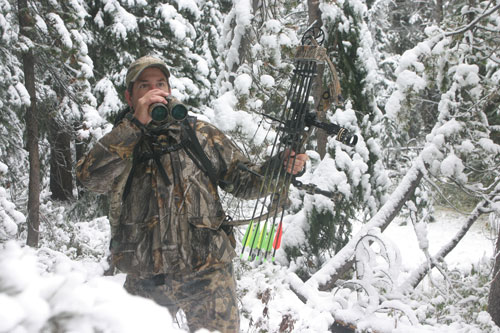 Contemplating an archery elk hunt? If you’re setting your sights on a trophy, you can’t be like everyone else. In fact, no matter what phase of the rut you’re in, breaking with traditional tactics may be your key to surprising success.
Contemplating an archery elk hunt? If you’re setting your sights on a trophy, you can’t be like everyone else. In fact, no matter what phase of the rut you’re in, breaking with traditional tactics may be your key to surprising success.
If pulling a fixated herd bull from the harem during estrus frustrates you, then the post-rut might bring you to the edge of despair. Although bulls still bugle and give clues like they want to continue their breeding fury, their lack of response says otherwise.
Miles Fedinec, a native Coloradan and guide for Atkinson Expeditions, has hunted this waning rut period more than once. Years of elk hunting have taught him to evaluate elk conversations quickly and respond accordingly. Instead of continuing a discourse with a talkative, but non-budging bull, Fedinec makes tracks in the post-rut.
“Before you consider a post-rut archery elk hunt, you need to understand what’s on a bull’s mind,” Fedinec says. “Any herd bull that’s been rutting hard for three or more weeks and bred 20 cows is ready for the rut to be over. He’s worn out and beginning to worry about winter, and whether he can replace some of the fat he just burned off.”
Fedinec relates it to you running a marathon. If you just finished one marathon, would you be ready to run one the next day? Plus, bulls have a second marathon coming up in the form of winter. They carefully consider every calorie-burning move from the post-rut on out.
“In the post-rut you have to be the active one,” Fedinec emphasizes. “It’s not uncommon to have a bull bugle back. In fact they can be downright over-responsive, but often that’s where it ends. That’s when you need to decide quickly on how to use a bull’s response to your benefit.”
Fedinec listens intently for the first few bugles to decipher whether the bull is moving one way or the other, or whether he is stationary. If the bull is close, Fedinec will even set up for a few minutes in case he can spark a curious look from a bull. More often than not, Fedinec has to run his own marathon. Using the bull’s bugles, Fedinec plots a course where he believes the bull will head.
This is where pre-scouting comes into play. You need to know a bull’s favorite bedding zone, favorite feeding locations, and any water stops where a bull may fill up. You also need to be acutely aware of wind direction and the thermals in your hunting area. After that, it’s a matter of gaining ground on a bull and eventually pulling ahead for an ambush.
Fedinec doesn’t entirely avoid calls. If he believes he’s successfully circled around a bull, yet can’t pinpoint the bull’s location, he’ll use a simple cow call or even challenge with a bugle. But that’s where it ends.
“If you’re hunting a property that’s seen lots of action, especially public land, elk are used to hearing elk calls. They’ve heard every call on the store shelf, so if you begin blowing it like a kazoo, you’re just telling other elk where you are at and that they should go the other direction.”
There’s another reason Fedinec hunts marathon-style in the post-rut. Any day tired bulls could begin making a migratory move, putting them four to 10 miles away overnight. Don’t bet on them being on the same mountain the next day.
“When the rut winds down, bulls know it’s time to begin their move for winter. They may move to a better feed location or to an area that traditionally gets less winter snow, but they are going to move,” Fedinec declares. “A bull will often do this as he finishes out his rutting behavior, so if you can locate him visually or through bugles, don’t sit back. Go after him.”






